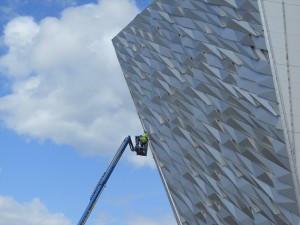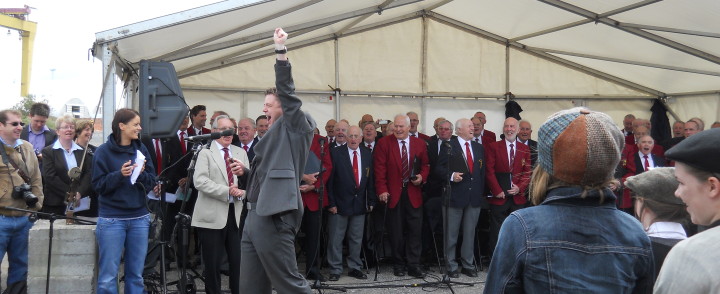BELFAST PREPARES TO COMMEMORATE THE TITANIC’S CENTENARY
by Ann Augunas
BELFAST – Ireland I’m standing in the middle of an ever-growing crowd of people here in Northern Ireland and a sense of great excitement is heightening all around me. All of a sudden I am emotionally involved in the whole of it as we are thrown back in time, to May 31, 1911. I can actually feel what it must have been like for the folks whose lives played out so enormously here at this famous shipyard of Harland & Wolff, birthplace of the Titanic and, at the time, the largest shipbuilding company in the world.
Powerful voices of combined gentlemen choirs are performing the soulful Naval hymn. Youngsters, boys and girls from surrounding schools, dressed as newspaper boys of that day, faces smudged with ink, are preparing to do their part in helping recreate this event. Then, at exactly 12:15 pm, a shot rings out. Voices reach high pitch and everyone cheers mightily, much as they did 100 years ago when the mighty RMS Titanic slipped into the waters of River Lagan at her launching. It was an experience I know I won’t forget.
Today a certain sense of expectation continues as Belfast positions itself for its role on the world stage come April 15, 2012 when it will commemorate the hundredth anniversary of what we have come to know as an unforgettable human tragedy, the sinking of the RMS Titanic on her maiden voyage to New York. Never ready to forget the lives lost, or how the lives of those who built Titanic were such an intimate part of the story, and how it all played out in history, Belfast is hard at work readying itself for the event.
Front and center is the ongoing construction of Titanic Belfast, a 97million British pound project that promises to be a “must-see” not only for the half million visitors expected next April, but also going forward as a permanent piece of Belfast history. This spectacular, 6-story, state-of-the-art structure, with an exterior design that represents the bows of three ships, will take visitors on a start-to-finish tour of the vessel’s construction, launch, maiden voyage and tragic end.
Also here in the Titanic Quarter, as the area is known, is the original SS Nomadic, one of 2 tenders that served the passengers of the Titanic. Nomadic was responsible for taking the ‘Lords, ladies, luggage and servants’ of first and second class passengers from Cherbourg, France, to the ship, while another vessel, the Traffic, ferried third-class passengers. The Nomadic was quite elegant, much smaller but similar in décor to its legendary counterpart, even to the small staircase, a copy of the one we have come to know thanks to films about the Titanic. It has been stripped down to be totally restored according to the designs and drawings of the day. It’s an unknown piece of history I found quite interesting.
Another integral piece of the story not-to-be-missed can be found at the world-class Ulster Folk & Transport Museum, located close by on 170 acres of Belfast’s countryside. Here all things Titanic (Titanica) can be viewed. The story of the White Star Line, the owners, the designers of the ships of the day, the drawings, photographs, and artifacts from the era, along with those found on the ocean floor. From road, rail and air modes of transport, on to the various buildings out-of-doors, visitors get a peek at life as it was lived back in Edwardian times. It’s a great exhibit that’s worth spending the several hours it takes to get to see most of it. You might also find information about the Ulster Folk & Transport Museum on Facebook, Twitter and You Tube.
Personally, I have to admit that visiting Belfast was never on my list of places to see in Ireland. Its sad history of dark days of intimidation and despair never resonated as a welcoming or safe place. The actual experience, though, was far from what I and other attending journalists had envisioned. To a person we agreed that Belfast was fascinating, its people warm and welcoming, and any visitor would feel totally at ease getting into the rhythms of the city. The eclectic mix of things to do and see, the grand architectural styles of its beautiful buildings such as City Hall, its churches, beautiful hotels, fine museums and cultural sites, its authentic Pubs and fine restaurants, are things any avid traveler will enjoy.
Interestingly, back in the 1900’s Belfast was one of the most prosperous industrial cities in the world, famous for its rope factories, cotton and flax, and being the world’s largest producer of linen. Great design skills and quality workmanship produced world-class steamships even though most of the necessary raw materials had to be imported. Over 30,000 people worked at Harland & Wolff at the time. Thanks to its energy, innovation, and well-organized working conditions, Belfast was at the pinnacle of success.
As for the future, once again it’s set to impact Ireland and the world. Samson & Goliath, two iconic, yellow cranes still standing in the shipyard at H & W, are now involved in the production of wind turbines. Projects going on within Belfast promise an increase of tourism to the area. The city itself is a place of wonderful contrasts, historic and beautifully old, yet cosmopolitan, trendy and new. And since food plays such a major part of travel, it’s important to know that all of Ireland possesses a world-class dining scene that’s on the ascendancy. Forget those former ideas of bland, Irish cooking because dining, along with entertainment and a lively nightlife, is alive and well in Belfast.
Suffice it to say, if you, too, are fascinated by the story of the Titanic, you might include Belfast in future travel plans, remembering that anytime is a good time to visit this new, up-and-coming, old city that’s making history all over again.
Visit www.tourismireland.com for information about travel to Ireland. Visit www.discovernorthernireland.com for information about Belfast.
Coming next; Part II, North from Belfast.





